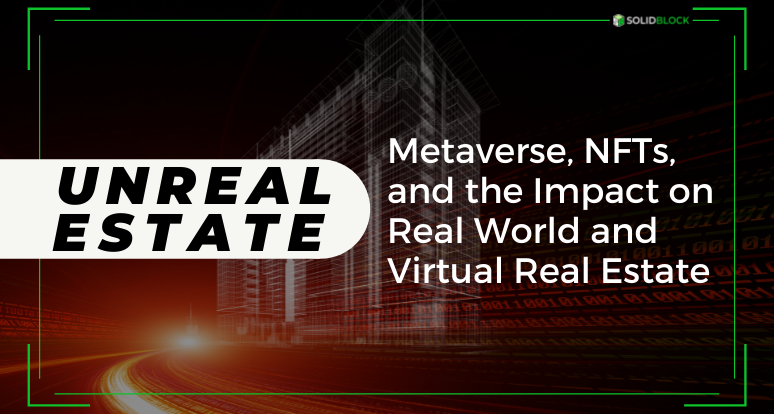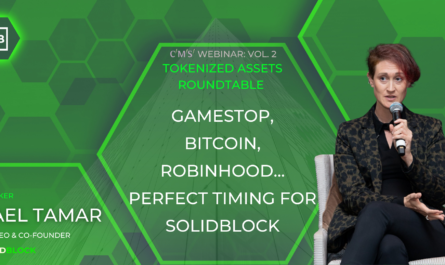
What is the Metaverse?
The metaverse doesn’t really exist. Not yet. Not really. It is a concept, a thought that has been hovering in the brains of the tech world for more than two decades. Imagine a collective virtual shared space that connects all virtual worlds together to create an endless playground where we can conduct our daily business. Perhaps it will be similar to the movies and games we immerse ourselves in. We are only at the beginning of this journey to predict what may become as rich a world as our own reality.
Two distinct trends are fueling the creation of the metaverse: the advance of technologies that allow us to enrich our online experiences, like AI and blockchain; and the fallout from the worldwide Covid epidemic, which pushed us to socialize online.
And why wouldn’t we want to focus on an alternative reality? Since 2020, our universe has had a hell of a time. A terrible virus wiped out more than 5.15 million people, and is still generating more deadly variants. There have been shootings, riots, fires, economic meltdowns, and wholesale regime changes—a plethora of bad news that assaults us daily. Our restricted travel and our fears have kept us close to home. Conferences are held online; university students have discovered new ways to cheat; tour guides and other professions have become obsolete; and businesses have scrambled to create an online presence. With our limited ability to socialize, we have turned to virtual ways of interacting.
Like many futuristic ideas, the metaverse gets its name from a 1992 novel, Snow Crash, by Neal Stephenson. In the story, the protagonist seamlessly moves between his reality as a pizza delivery guy in a dystopian present, and an alternate computer-generated existence.
Think of the 2018 movie Ready Player One that came out seven years after Earnest Cline’s novel of the same name. Perhaps that’s what the metaverse will eventually look like. Understandably, it takes time for technology to catch up with our imaginations.
Facebook’s Name Change
Today, one of the biggest proponents of the metaverse is Facebook’s Chief Executive Mark Zuckerberg. “In many ways the metaverse is the ultimate expression of social technology,” he explained.
Zuckerberg declared in July that Facebook would shift from existing as simply a social media company to an all-encompassing “metaverse company.” This September, they announced a two-year grant of $50 million set aside for partnerships that strengthen the interpersonal connection between reality, virtual reality , and consumer hardware, and to promote the development of metaverse products. And this October, Facebook changed its name to “Meta,” with full connotations of moving forward with this plan. With more than 1.5 billion people using Facebook daily, Facebook’s attempts to imagine what social media might look like in a metaverse is worth observing.
“The metaverse won’t be built overnight by a single company,” reads a company statement. “We’ll collaborate with policymakers, experts and industry partners to bring this to life.”
Neal Stephensen’s reaction? “After all the buildup in the last few weeks, the Meta announcement has a ripping-off-the-bandaid feeling.”
Metaverse Precursors
The precursors to the metaverse are active, engaging, and popular. There is Second Life, the largest user-created 3D universe, launched in 2003. Perhaps you were young enough to enjoy Club Penguin, a seamlessly crafted massive multiplayer online world for children that existed from 2005 to 2017. Minecraft, Fortnite, and even Animal Crossing invite players to participate with an avatar to socialize, build, battle, and buy-and-sell in an internal marketplace. This September, DeFi Land raised $4.1M to launch a decentralized finance project that turns investment activities in a rural, agricultural setting into games.
In a blending of realities, Fortnite recently hosted an all-day concert with Ariana Grande that topped the record of 12.3 million live viewers set by rapper Travis Scott in 2020. What we currently see are activities we once thought of belonging only to the real world—concerts, banking, building— developing a metaverse equivalent.
Which brings us to real estate. If the metaverse can mimic our reality, then buying and selling property is going to develop into big business.
How Technology Moves us Closer to a Metaverse
If Covid has been the catalyst for the eruption of online activity, the burgeoning of disruptive technology has been the slow and steady fire that is turning our world on its head.
Think of the metaverse as a possible extension of the internet. It uses the internet, virtual reality (VR), augmented reality and other tech to create shared digital spaces, content and experiences. It can be accessed from your computer, or your phone, or your VR goggles. It will always be on, and it will happen in Real Time.
Perhaps the next time you want to go shopping, instead of just clicking on a list of items to add to your virtual cart, you’ll enter a grocery store as your avatar, an experience as consuming as if you were there in person. You’ll pull items off shelves, drop them in your cart, where they are automatically scanned and tallied, and two hours later, the groceries will be delivered to your real world door.
While you’re waiting for your delivery, you’ll “walk” across the street to an art gallery, or buy a ticket to hear a concert. Or maybe you’ll visit a dragon farm, or ride bronco busters in the Wild West.
Now you begin to wonder. Who owns the grocery store? Who owns the gallery? How was it paid for? Does this unreal estate have a real value? Who is profiting from your presence in these stylishly fashioned buildings and landscapes? Who owns the virtual “land” that it was built on? And what technology is powering the advent of this experience?
Though the metaverse is still a nebulous concept, one central element will be the ability to move both your avatar and your assets effortlessly and instantly through virtual worlds. Blockchain is what makes this possible.
What is Blockchain?
A blockchain is a digital record of transactions. The name comes from its structure, in which individual records, called blocks, are linked together in a single list, called a chain. Blockchains are used for recording transactions made with cryptocurrencies, such as Bitcoin, and have many other applications. As early as 1991, a paper entitled “How to Time-Stamp a Digital Document” suggested a practical way to certify the creation of or modification of a document digitally. By 2009, when the anonymous Satoshi Nakamoto mined the first Bitcoin, they also built upon previous ideas to create blockchain as a way to transact peer-to-peer electronic cash payments that cut out the middleman – namely banks and other large institutions.
Blockchain is a type of distributed ledger technology (DLT) that organizes transactions in a “shared, distributed database.” DLT is an umbrella term for blockchain and other similar tech. Blockchain, however, did not allow for additional information to be added to the minimum details of a Bitcoin transaction. That changed in 2013, with the appearance of smart contracts on the Ethereum platform, technology that again was built on previous ideas expressed as early as 1996.
What are Smart Contracts?
Smart contracts are code that allow parties involved in a transaction to add significant obligations in an if-then form. For example, if Party A transfers a specific amount of money, then Party B is obligated to provide the deed to one specific apartment. These contracts execute the transaction independently once terms are met, and ensures the agreement is adhered to. These contracts can exist between more than one person, either as individuals or as organizations.
Almost anything can be exchanged using a smart contract, from money, real estate, securities, and even data. Smart contracts are stored and replicated in a DLT. There can be no falsifications or deletions to information once a contract is set. And, the anonymity of the parties is ensured through the encryption of data.
The advantages of using a smart contract in a transaction include the speed at which a transaction can occur as it sidesteps preparing documents by hand and is self-executing; the savings due to cutting out a middleman and instead communicating peer-to-peer; the reliability of data based on the fact that data entered into a smart contract cannot be changed or tampered with; and the accuracy of information and the execution of the stated contract. Blockchain and smart contracts decentralize the centralized financial system. In terms of data liquidity, blockchain creates network-centric alliances rather than data being concentrated in one main server.
It is this power of blockchain, combined with the durability of smart contracts, that allow the monies in virtual worlds to be linked to the exchange of cryptocurrencies in the real world, bringing full circle the concept of real life mirroring life in a virtual reality. What is crucial in this arrangement is the type of coins—or tokens—that assets are assigned.
Different Types of Tokens
According to tokenex.com, tokenization is the process of substituting a sensitive data element with a non-sensitive equivalent or token that has no extrinsic or exploitable meaning or value. The token is a reference that maps back to the sensitive data through a tokenization system.
There are three types of tokens.
A payment token is used to represent an intrinsic and fungible amount. It is a coin like Bitcoin or Dogecoin that gains or loses value according to supply and demand. They can be used to purchase real estate or other real world assets and they are interchangeable in a one-to-one value.
Next are security tokens. These tokens denote equity or security shares that were converted into a digital token. In the case of real estate, they are often shares in a special purpose vehicle (SPV) that buys, sells, manages, and expands real world real estate. An investor will own a security issued and backed by the SPV that is the legal holder of the property.
Non-fungible tokens (NFTs) are a type of digital asset or token that are not fungible, meaning they cannot be traded on a one-to-one monetary value because each unit has unique qualities that add or subtract to its value. While they can be bought and sold, they are more like digital collectibles. Think of a baseball card collection where some cards—based on the player depicted, the condition, and the age of the card—are more valuable than others. Or of the art world, where owning a Picasso means the holder of this rare and rarified artwork is the rightful owner of the underlying asset as well.
Now, even Picasso is entering the digital age. Because NFTs can be linked to real world assets, as recently as June 2021, Sotheby’s initiated a sale of an NFT of a digitized “twin” of a Picasso painting.
As the NFT hype continues to spread, there are reports of millions of dollars being spent on the equivalent of the digital pet rock, the drawing series of “Bored Ape,” and more fanciful—or outlandish—virtual “stuff”.
NFTs have also replaced the utility token, an item that gives the holder access to a blockchain-based product or service, for example, a timeshare. Each token represents a specific number of points or equivalent measurement applicable towards your next purchase. Think of this type of NFT as a gift card you buy for use in a specific store or a public transport card valued at a specific amount of money for use on several types of transportation. These are utility tokens. A utility token is generally bought with the intention of future use.
Buying Real Estate with NFTs
Trends in new and disruptive technology are not only affecting the virtual world, they are also impacting the real world.
Real estate is one of the last asset classes to be upended by technology. As the shared economy of Uber and Airbnb has disrupted ownership, so too the world of security tokens and NFTs may be making a giant shift in the extremely stolid universe of property transactions.
In a world where the global value of real estate is more than $200 Trillion, but less than 1% is liquid, tokenization will increase market liquidity and offer peer-to-peer transactions, bypassing centralized banks altogether.
In June 2021, Propy, a blockchain real estate start-up located in California, auctioned the first ever real world property as an NFT. Owned by TechCrunch founder Michael Arrington, the apartment, located in Kiev, was auctioned for 36 ETH (approximately $93,000 at the time of sale).
“This NFT will go down in history. For Propy it is a major milestone in leveraging the promise of blockchain technology and non-fungible tokens (NFT) to achieve ‘self-driving’ real estate transactions and real estate participation in the decentralized finance economy,” said Natalia Karayaneva, CEO of Propy.
The Kiev property, which was once owned by a USA-based entity, now has a new owner of the NFT, and thus the property itself. This process will be repeated every time the NFT attached to the property is resold, meaning a property can be transferred between two wallets, peer-to-peer with no central bank involvement, no mortgage, and no need to change the name of the owner in the land registry.
Karayaneva believes this first NFT sale is only the beginning of a sea of change in the way traditional real estate deals are transacted.
Another jolt to the traditional real estate market is the tokenization of large property deals. In this case, real world assets are digitized as security tokens. A new report by Moore Global suggests that tokenized real estate will become a $1.4 trillion industry within just five years.
In fall of 2021, SolidBlock added two new tokenized real estate projects to its digital marketplace. Its vetted and secure platform offers investors accessibility to exclusive international deals, a lower minimum investment threshold, and higher returns on investment. Tokenization gives investors control over when to invest in a project, and the ability to trade and liquidate on their own schedule.
As an aside, SolidBlock transforms real world assets into digital securities. An NFT is one token representing one product and has a single owner. If an NFT were to be broken into fractions, it would, in essence, become a digital security and would then be traded under SEC (US Securities and Exchange Commission) regulations.
Unreal Estate and NFTs: Following the Trends
Perhaps the top virtual property worlds to date are The Sandbox, Genesis City, and Decentraland. In addition, the world’s first virtual real estate company, Metaverse Property, launched in December 2020.
What is a virtual real estate company? For those individuals who are too uncertain to make purchases themselves, Metaverse Property facilitates the buying and selling of virtual property along with a full suite of services provided by pioneers of the blockchain and non-fungible token (NFT) industry. They have also created the first virtual real estate investment trust (REIT) to represent the various metaverses that are growing at a rapid pace.
Decentraland is a decentralized 3D virtual reality platform powered by the Ethereum blockchain. Opened to the public in February 2020, the object of Decentraland is to buy plots of LAND with their internal currency, MANA, and build on or rent your space so as to attract an income-generating project.
As with real world properties, location is a factor; those plots closest to the world’s point of entry are considered more desirable. Of course, the structure that you build on your LAND will also add to your property’s worth. As of now, visitors to Decentraland can attend concerts, have Domino’s Pizza delivered to their real world door, visit art galleries and buy art NFTs, visit a farm, or even ener a fun house.
Same Same But Different
As an article in Republic points out, digital real estate investing is a serious business. When Decentraland had an initial coin offering (ICO), they sold more than $24M in MANA in less than 35 seconds. A virtual plot bought in January 2021 for $2,000 increased in value in two months to $175,000. In November, the most recent purchase of a plot of LAND in Decentraland was bought for a record $2.34M by Metaverse Group and is more than double the previous record for a sale of land or property within a virtual reality world. The 500-square-meter plot will be used to host virtual fashion shows for avatars that can be bought with MANA, creating a closed economic cycle within Decentraland.
Republic Realm is also building a metaverse-like virtual world, and in November, launched a virtual cruise ship in that realm.
Investing in digital real estate is simple. In the transfer of real-world real estate, money is exchanged for real property and the transaction involves banks, finance companies, lawyers, and title companies. In a similar manner, virtual unreal estate is exchanged, usually for virtual currency, often in the form of NFTs. These more decentralized financial transactions cut out the banks, but do allow for checks such as KYC (know your customer) and AML (anti-money laundering) before business is conducted.
Don’t let the fact the real estate was purchased virtually fool you. The blank canvas that is virtual real estate is growing by leaps and bounds, and the creation of an all-encompassing, three-dimensional, virtual reality-infused ecosystem is the wave of the future.
Check your skepticism at the door. Technology is years away from supporting a fully-fledged metaverse. But the impact the pre-metaverse is having on finance and real estate today is real. Jump in and open your virtual parachute.
- Haber, Stuart, and W. Scott Stornetta, “How to Time-Stamp a Digital Document,” Journal of Cryptology, Vol. 3, No. 2, pp. 99-111, 1991.
- Yun, Yohan, “Before Blockchain, There Was Distributed Ledger Technology,” BlockstreetHQ, September 6, 2018.
- “What are Smart Contracts?” CryptoNinjas

 by
by 

